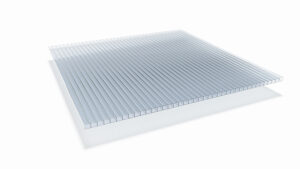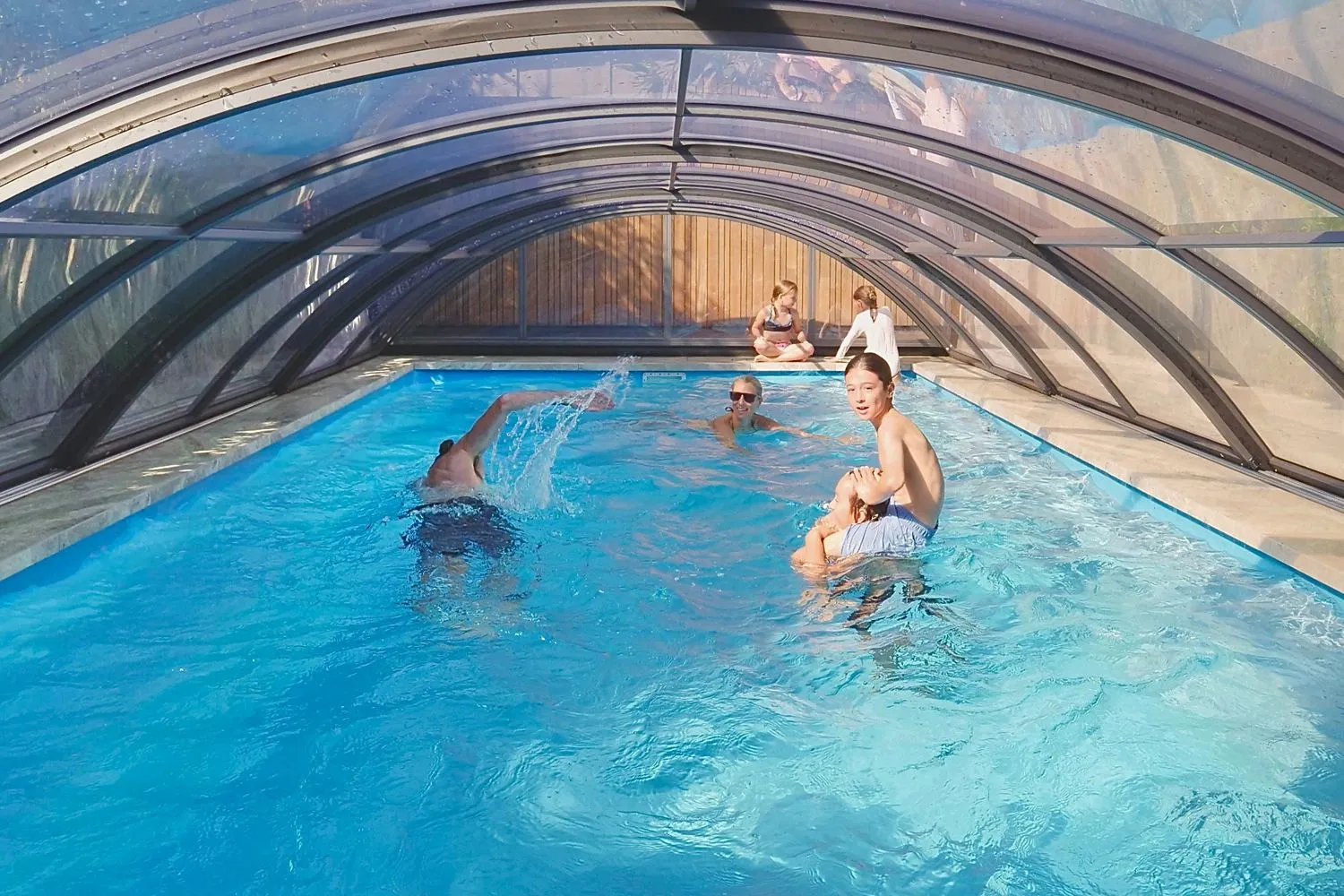A properly maintained pool enclosure will survive for 20 to 35 years.
The construction of these structures includes durable materials which protect them from environmental elements. The structures withstand sunlight and rain and wind conditions without showing any signs of deterioration. Homeowners need to perform occasional maintenance on these structures to ensure their longevity.
Understanding the elements that influence product durability enables users to make basic decisions which safeguard their investment and maintain their pool availability for swimming at any time.
Factors That Shorten or Extend Pool Enclosure Lifespan
1. Material Quality
Aluminium Frames (Up to 35 years)

The powder-coated aluminium material shows excellent resistance to rust and demonstrates strong performance in coastal environments.
The protective coating functions as a defensive layer which prevents salt air moisture from reaching the metal. Basic maintenance will extend the lifespan of these frames to multiple decades.
The powder coating establishes an impenetrable barrier which protects the metal from corrosion. The protective coating on aluminium surfaces effectively repels salt spray and humidity and pool chemicals.
The use of aluminium frames in homes remains possible because the material resists rust degradation even after multiple years of exposure.
What helps them last:
- Rinse the frames with fresh water every few weeks if you live near the coast
- Put silicone oil on moving parts and locks three times each year
- Wipe away any salt build-up before it causes problems
- Check for any chips in the coating and touch them up quickly
The silicone oil keeps hinges and locks working smoothly. When metal parts grind against each other without lubrication, they wear down much faster. A small bottle of silicone spray costs a few dollars and lasts ages.
Polycarbonate Panels (Around 20 years)

The panels consist of material which resists shattering like glass thus providing enhanced safety for children and domestic animals. The panels maintain their clarity because they were designed to withstand powerful UV radiation. The panels require periodic cleaning to maintain their clear appearance.
Polycarbonate material demonstrates absolute resistance to damage when compared to glass. During a hailstorm, the material can withstand the impact of hailstones without sustaining any damage to its surface.
The material’s high strength makes it suitable for pool enclosure applications because it can withstand accidental impacts. The material absorbs impact damage without sustaining any harm to continue operating.
How to keep them clear:
- Use mild soap and soft cloths when cleaning
- Stay away from harsh chemicals like acetone or petrol
- Clean gently to avoid scratching the surface
- Rinse thoroughly after washing to remove soap residue
Scratches on panels catch dirt and make them look cloudy over time. Using the wrong cleaning products can actually melt or craze the surface, leaving permanent damage. Stick to what the manufacturer recommends and your panels will stay transparent for their full 20-year lifespan.
2. Maintenance and Cleaning
Regular upkeep can add five to ten extra years to your enclosure’s life. Small jobs done regularly beat big repairs later. Most people don’t realise how much difference a bit of preventive care makes until something goes wrong.
Simple tasks that make a difference:
- Clear leaves and dust from tracks so modules slide smoothly
- Oil sliding parts and locks three times yearly with silichrom spray
- Clean stainless steel bits four times a year with proper cleaners
- Open doors or vents regularly to let moisture escape
The entire system experiences reduced stress when all tracks operate at a smooth pace. The parts experience extended lifespan because they move without resistance.
The formation of condensation due to humidity will result in mold or corrosion damage when left untreated. The enclosure needs daily exposure to fresh air for one hour to prevent moisture accumulation. The practice of performing this daily task helps prevent major system failures which require expensive repairs.
Stainless steel fittings will experience corrosion even though they carry the name stainless. The surface requires specialized cleaners which create a protective film after application.
The correct cleaning solution for this task requires more than regular car wash soap. Your investment will receive protection through purchasing the correct product at a slightly higher cost.
3. Weather and Seasonal Care
Australian weather brings heat, humidity, and strong winds rather than snow and ice. Your enclosure needs care that matches these conditions. What works in cold climates doesn’t always apply here.
Before storms hit:
All doors and modules need to be secured by tight locking mechanisms. Track stops need to be installed because high winds can cause unexpected movement of objects.
A module that becomes detached during a storm will cause damage to itself and the entire structure.
The five-minute storm preparation process protects your structure from expensive repair expenses that could reach thousands of dollars. The process of checking locks becomes automatic after performing it several times.
The security of your property will give you peace of mind during severe weather conditions.
When winds pick up (above 45 km/h):
Keep everything locked and secured. Wind can push hard against panels and frames when they’re not fastened properly. Even a well-built enclosure will suffer if modules are left partially open during strong winds.
The wind doesn’t just blow steadily. It gusts and swirls, creating pressure that can pop panels out or bend frames. Locked modules distribute the load evenly across the structure instead of stressing individual points.
During hot summer months:
The system requires periodic venting through doors and vents to let hot air escape. Excessive heat exposure will damage panels through time while accelerating material deterioration. The greenhouse effect inside enclosed spaces creates temperatures that exceed outside air temperatures by significant margins.
The pool area becomes unbearable when the water temperature reaches bathwater levels because the system operates as a massive solar heater. The system maintains comfortable water temperatures while safeguarding users from heat-related illnesses. Win-win.
After storms pass:
The process of cleaning away dust and debris and salt spray should happen immediately. The process of corrosion prevention begins immediately when you clean the area because it maintains your equipment in good condition. The sun will bake dirt into the surface which makes future cleaning operations significantly more difficult.
Your enclosure will survive beyond thirty years when you follow all weather-related maintenance procedures. The owners who maintain their best seasonal care routines will achieve the longest possible lifespan for their enclosures.
4. Pool Water Chemistry
Balanced water stops your frame and fittings from wearing out too soon. Chemical imbalances eat away at aluminium and cloud up panels faster than you’d think. Water that’s too acidic or alkaline becomes aggressive towards anything it touches.
Keep these levels steady:
- pH between 7.2 and 7.6 works best
- Chlorine between 0.3 and 0.6 mg/L does the job
- Skip chemicals with active oxygen or ozone because they damage aluminium and panels
Weekly water testing requires only five minutes of your time to prevent costly future problems.
Test strips offer affordable usage with simple operation. The test process involves pool water immersion followed by a brief waiting period before matching strip colors to a reference chart. The testing process remains simple enough for children to perform.
The chemical properties of pool water impact both human swimmers and pool equipment. The combination of high chlorine levels in the air causes metal equipment damage which results in panel clouding.
The water becomes acidic when its pH level decreases to below normal range which leads to complete destruction of all contact materials. The maintenance of proper chemical equilibrium protects both your pool equipment and your pool enclosure.
Some pool owners believe that higher chemical concentrations lead to cleaner water. The process of water treatment does not function in this manner.
Excessive chemical addition leads to increased contamination without providing any safety benefits. The recommended chemical ranges will create happiness for all pool users including your pool enclosure.
5. Safe-Use Tips
Using your enclosure the right way prevents accidental damage and keeps it working smoothly for longer. Most damage comes from misuse rather than manufacturing defects.
Follow these simple rules:
- Don’t walk, sit, or hang on the structure because it’s not designed for that
- Check tracks are clear before sliding modules to avoid jamming
- Lock doors and modules when nobody’s using the pool
- Let only adults operate electric mechanisms after checking tracks are clear
Children enjoy climbing on objects yet the enclosure functions as a safety barrier instead of a jungle gym. The structure remains secure when you issue periodic safety alerts to visitors.
The panels and frames of your structure were designed to withstand wind and weather conditions instead of supporting human weight during climbing attempts.
Any objects placed inside the tracks will block the module movement when you attempt to slide them. The electric motors inside their strong enclosures are not built to push through any blockages. The process of forcing these mechanisms will damage their gears while simultaneously causing motor failure.
The pool locking system protects children from entering the pool area without adult supervision.
Pool safety requires absolute attention to detail. The main advantage of owning a pool becomes useless when the locking mechanism remains unsecured.
All electric systems require proper treatment. The system operates with sufficient power to create dangerous finger traps which could harm anyone who enters its path. All users must verify the path is clear before activating the button.
The process of teaching teenagers to handle controls safely requires patience because it stops accidents from happening.
Conclusion
A pool enclosure built with quality materials will provide 20 to 35 years of service when you perform scheduled maintenance.
The Australian environment requires owners to monitor their pool enclosures for coastal corrosion and heat exposure and storm readiness. The practice of pool maintenance will become automatic after you develop a regular routine.
Your pool enclosure should be treated as a permanent investment instead of a temporary installation that you will forget about.
The investment will provide you with multiple decades of protected swimming during every season of the year. The work you do today will benefit your pool for numerous future summers by preventing costly repairs and maintaining your outdoor space.
Homeowners typically incorporate pool maintenance into their regular weekend activities which include other outdoor duties. A properly maintained pool enclosure safeguards your pool water while extending your swimming period and increases your property worth during home sale.
If you want a long-lasting enclosure that protects your pool and adds real value to your home, explore our full range of high-quality pool enclosures.
FAQ
Will the panels in my pool enclosure eventually turn yellow or lose their clarity over time?
Quality panels maintain their resistance to yellowing for twenty years when users follow proper care instructions. The use of mild soap during regular cleaning helps stop premature color changes. The use of harsh chemicals will accelerate aging so users should select gentle cleaning products.
How well can a pool enclosure stand up to hail and stormy weather?
The shatter-resistant properties of polycarbonate panels make them more effective at withstanding hail than glass does. The structure remains protected from wind damage when modules stay locked during intense storms.
If a pool enclosure gets installed, will it add noticeable value to the property when selling?
Pool enclosures boost property value through their ability to extend swimming seasons and minimise maintenance requirements. Homebuyers value the energy efficiency of pool water that stays warm while using fewer chemicals. The market views high-quality enclosures as exclusive features which differentiate properties from comparable homes.
What special care do pool enclosures need close to the coastline where salt air is common?
The frames of coastal properties require regular cleaning because salt accumulation causes faster corrosion. The combination of weekly fresh water rinses with silicone oil application on moving parts serves as protection against salt air. The process of cleaning fittings needs to occur four times per year to stop pitting from occurring.
